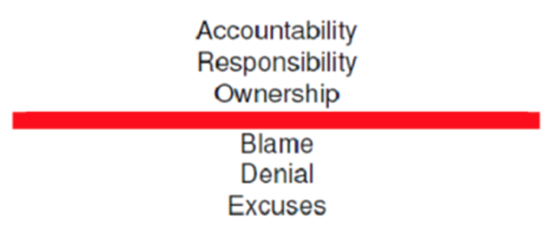Choosing to Live Above the Line

POSTED ON: Monday, July 18th, 2016
CATEGORIES: Business Strategy and Planning, Leadership and Management, Sales
You are driving and suddenly someone cuts in front of you. You brake quickly, heart racing and …. How do you react?
- Hit the horn?
- Flashing of headlights?
- A torrent of abuse aimed at the irresponsible driver in front of you?
Not untypical reactions; we don’t consciously think about it – it just happens!
Now think about how you approach difficult business situations. Are you open minded, or are you defensive from the word ‘go’? The latter is not unlike the road-rage scenario. In the workplace anger and rage comes out as defensiveness, denial, blame and justification.
The Line of Choice?
In our work we can draw a line – the ‘line of choice’ – between the default, automatic responses and the more constructive responses:

The automatic responses are ‘below the line’ whilst the alternatives lie ‘above the line’. Note the word ‘choice’; early in my career I had a boss who wouldn’t accept any below the line attitudes. His maxim was “don’t be a victim” and he would steer any conversation around to “what do you recommend now?”; “how are we going to solve this?”; “given xxx, what are we going to do?” He demonstrated personal choice achieved results personally and through his team that many other leaders could not.
Taking the high road takes some practice. American psychotherapist and author Tara Bennett-Goleman calls it the ‘magic quarter second’: the time between a situation developing and our reacting to it. Of course not every situation is “in the moment”. There are others that have longer lasting impact; the 2008 banking crisis; the Brexit vote etc. However you can still chose to look at it through an above the line lens and keep the ability to effect change in your hands.
How do I operate above the line?
Step 1: Recognise the dynamics when you and your team operate above the line; Thinking before responding; Respect for others’ positions; Actively listening; Taking responsibility for individual input; Taking ownership for your own role. Contrast this with a below the line behaviours; Defensiveness, blame, denial and justification. Being aware of the differences equips you move to step 2.
Step 2: Recognise below the line behaviours as they happen and take action to put you and your team in the space above the line; name the below the line action (note – not the person). You can do this by following my ex-boss’ example and asking questions. Your aim is to be aware of things are unfolding around you and to be increasingly ‘present’ and ‘in the moment’ so that you can take action to move the conversation into a better place.
With practice, you’ll will change not only the way in which you see and react to events but also set a culture for the entire team that always looks at how to get the best out of every situation. In so doing you will put power back in your hands and enable positive conversations leading to powerful solutions, strategies and plans.